Evaluation of Particulate Matter (PM) Emissions from Combustion of Selected Types of Rapeseed Biofuels
Abstract
1. Introduction
- Insoluble Organic Fraction (IOF—a part of INSOL), in other words, carbon in the form of soot and products of incomplete combustion of fuel and oil additives;
- Insoluble inorganic fraction (INSINOF—a part of INSOL), which consists of ashes, sulfates, trace elements such as iron, phosphorus, calcium, chromium, etc., and mechanical impurities from the environment;
- Soluble Organic Fraction (SOF), organic substances absorbed on soot particles (mainly hydrocarbons formed from the incomplete combustion of fuel PMFUEL and oil PMLUBE);
- Soluble Inorganic Fraction (SINOF), resulting mainly from the presence of sulfur in the fuel, from which sulfuric acid is formed following combustion and because of the presence of water vapor;
- Soluble Organic Fraction (SOF), which consists mainly of unburned hydrocarbons resulting from local oxygen deficiency or excess from flame extinction near the cooler cylinder walls or from a drop in charge temperature during expansion.
2. Materials and Methods
2.1. Boiler Tests
2.2. Engine Tests
2.3. Statistical Analysis
3. Results and Discussion
3.1. Boiler Test Results
3.2. Engine Test Results
4. Conclusions
Author Contributions
Funding
Data Availability Statement
Conflicts of Interest
References
- Werle, S. Termiczne Przetwarzanie Biomasy Odpadowej Jako Element Gospodarki Obiegu Zamkniętego; Wydawnictwo Politechniki Śląskiej: Gliwice, Poland, 2021; ISBN 83-7880-764-9. [Google Scholar]
- Rogowska, D. Wykorzystanie OZE w Energetyce a Zrównoważony Rozwój. Nafta-Gaz 2017, 73, 616–623. [Google Scholar] [CrossRef]
- Dołżyńska, M.; Obidziński, S.; Piekut, J.; Yildiz, G. The Utilization of Plum Stones for Pellet Production and Investigation of Post-Combustion Flue Gas Emissions. Energies 2020, 13, 5107. [Google Scholar] [CrossRef]
- Król, D.; Łach, J.; Poskrobko, S. O Niektórych Problemach Związanych z Wykorzystaniem Biomasy Nieleśnej w Energetyce. Energetyka 2010, 1, 53–62. [Google Scholar]
- Juszczak, M. Concentrations of Carbon Monoxide and Nitrogen Oxides from a 15 KW Heating Boiler Supplied Periodically with a Mixture of Sunflower Husk and Wood Pellets. Environ. Prot. Eng. 2014, 40, 65–74. [Google Scholar] [CrossRef]
- Wasilewski, J.; Zając, G.; Szyszlak-Bargłowicz, J.; Kuranc, A. Evaluation of Greenhouse Gas Emission Levels during the Combustion of Selected Types of Agricultural Biomass. Energies 2022, 15, 7335. [Google Scholar] [CrossRef]
- Kachel, M.; Kraszkiewicz, A.; Subr, A.; Parafiniuk, S.; Przywara, A.; Koszel, M.; Zając, G. Impact of the Type of Fertilization and the Addition of Glycerol on the Quality of Spring Rape Straw Pellets. Energies 2020, 13, 819. [Google Scholar] [CrossRef]
- Kraszkiewicz, A.; Santoro, F.; Pascuzzi, S. Emmission of Sulphur Oxides from Agricultural Solid Biofuels Combustion. Agric. Eng. 2020, 24, 35–45. [Google Scholar] [CrossRef]
- Lech-Brzyk, K. Emisja wybranych zanieczyszczeń podczas spalania biomasy w kotłach o mocy 2÷4 MW. Ochr. Środowiska 2014, 36, 47–52. [Google Scholar]
- Vicente, E.; Alves, C. An Overview of Particulate Emissions from Residential Biomass Combustion. Atmos. Res. 2018, 199, 159–185. [Google Scholar] [CrossRef]
- Johansson, L.; Tullin, C.; Leckner, B.; Sjövall, P. Particle Emissions from Biomass Combustion in Small Combustors. Biomass Bioenergy 2003, 25, 435–446. [Google Scholar] [CrossRef]
- Demirbas, A. Hazardous Emissions from Combustion of Biomass. Energy Sources Part A Recovery Util. Environ. Eff. 2007, 30, 170–178. [Google Scholar] [CrossRef]
- Hawrot-Paw, M.; Koniuszy, A.; Sędłak, P.; Seń, D. Functional Properties and Microbiological Stability of Fatty Acid Methyl Esters (FAME) under Different Storage Conditions. Energies 2020, 13, 5632. [Google Scholar] [CrossRef]
- Matwijczuk, A.; Zajac, G.; Kowalski, R.; Kachel-Jakubowska, M.; Gagos, M. Spectroscopic Studies of the Quality of Fatty Acid Methyl Esters Derived from Waste Cooking Oil. Pol. J. Environ. Stud. 2017, 26, 2643–2650. [Google Scholar] [CrossRef] [PubMed]
- Badura, X. Profil Składu Chemicznego Cząstek Stałych (PM) Emitowanych Przy Zastosowaniu Paliw z Biokomponentami. Nafta-Gaz 2014, 70, 817–824. [Google Scholar]
- Chłopek, Z. Ekologiczne Aspekty Motoryzacji i Bezpieczeństwo Ruchu Drogowego; Wydział Samochodów i Maszyn Roboczych Politechniki Warszawskiej: Warszawa, Poland, 2012. [Google Scholar]
- Bowe, B.; Xie, Y.; Yan, Y.; Al-Aly, Z. Burden of Cause-Specific Mortality Associated with PM2.5 Air Pollution in the United States. JAMA Netw. Open 2019, 2, e1915834. [Google Scholar]
- Sharma, S.; Chandra, M.; Kota, S.H. Health Effects Associated with PM2. 5: A Systematic Review. Curr. Pollut. Rep. 2020, 6, 345–367. [Google Scholar] [CrossRef]
- Yin, P.; Brauer, M.; Cohen, A.J.; Wang, H.; Li, J.; Burnett, R.T.; Stanaway, J.D.; Causey, K.; Larson, S.; Godwin, W. The Effect of Air Pollution on Deaths, Disease Burden, and Life Expectancy across China and Its Provinces, 1990–2017: An Analysis for the Global Burden of Disease Study 2017. Lancet Planet. Health 2020, 4, e386–e398. [Google Scholar] [CrossRef]
- Alves, C.; Evtyugina, M.; Vicente, E.; Vicente, A.; Rienda, I.C.; de la Campa, A.S.; Tomé, M.; Duarte, I. PM2.5 Chemical Composition and Health Risks by Inhalation near a Chemical Complex. J. Environ. Sci. 2023, 124, 860–874. [Google Scholar] [CrossRef]
- EEA, E. Air Quality in Europe—2019 Report; European Environment Agency: Copenhagen, Denmark, 2019. [Google Scholar]
- Šarkan, B.; Jaśkiewicz, M.; Kubiak, P.; Tarnapowicz, D.; Loman, M. Exhaust Emissions Measurement of a Vehicle with Retrofitted LPG System. Energies 2022, 15, 1184. [Google Scholar] [CrossRef]
- Chłopek, Z.; Szczepański, T. Ocena Zagrożenia Środowiska Cząstkami Stałymi Ze Źródeł Cywilizacyjnych. Inżynieria Ekol. 2012, 30, 174–193. [Google Scholar]
- MAHA MPM4 Partikelmessgerat. Original-Betriebsanleitung; MAHA Maschinenbau Haldenwang GmbH & Co. KG: Haldenwang, Germany, 2008. [Google Scholar]
- Chojnacki, J.; Ondruška, J.; Kuczyński, W.; Šooš, L.; Bałasz, B. Emissions from the Combustion of Solid Biofuels. In Proceedings of the 9th International Scientific Symposium on Farm Machinery and Process Management in Sustainable Agriculture, Lublin, Poland, 22–24 November 2017; pp. 70–75. [Google Scholar]
- Yang, W.; Zhu, Y.; Cheng, W.; Sang, H.; Yang, H.; Chen, H. Characteristics of Particulate Matter Emitted from Agricultural Biomass Combustion. Energy Fuels 2017, 31, 7493–7501. [Google Scholar] [CrossRef]
- Carroll, J.; Finnan, J. Emissions and Efficiencies from the Combustion of Agricultural Feedstock Pellets Using a Small Scale Tilting Grate Boiler. Biosyst. Eng. 2013, 115, 50–55. [Google Scholar] [CrossRef]
- Garcia-Maraver, A.; Zamorano, M.; Fernandes, U.; Rabaçal, M.; Costa, M. Relationship between Fuel Quality and Gaseous and Particulate Matter Emissions in a Domestic Pellet-Fired Boiler. Fuel 2014, 119, 141–152. [Google Scholar] [CrossRef]
- Simões Amaral, S.; Andrade de Carvalho, J., Jr.; Martins Costa, M.A.; Pinheiro, C. Particulate Matter Emission Factors for Biomass Combustion. Atmosphere 2016, 7, 141. [Google Scholar] [CrossRef]
- Limousy, L.; Jeguirim, M.; Dutournié, P.; Kraiem, N.; Lajili, M.; Said, R. Gaseous Products and Particulate Matter Emissions of Biomass Residential Boiler Fired with Spent Coffee Grounds Pellets. Fuel 2013, 107, 323–329. [Google Scholar] [CrossRef]
- Rybak, W. Spalanie i Współspalanie Biopaliw Stałych; Oficyna Wydawnicza Politechniki Wrocławskiej: Wrocław, Poland, 2006; ISBN 83-7085-938-0. [Google Scholar]
- Musialik-Piotrowska, A.; Kordylewski, W.; Ciołek, J.; Mościcki, K. Characteristics of Air Pollutants Emitted from Biomass Combustion in Small Retort Boiler. Environ. Prot. Eng. 2010, 36, 123–131. [Google Scholar]
- Niu, Y.; Tan, H. Ash-Related Issues during Biomass Combustion: Alkali-Induced Slagging, Silicate Melt-Induced Slagging (Ash Fusion), Agglomeration, Corrosion, Ash Utilization, and Related Countermeasures. Prog. Energy Combust. Sci. 2016, 52, 1–61. [Google Scholar] [CrossRef]
- Fournel, S.; Palacios, J.; Morissette, R.; Villeneuve, J.; Godbout, S.; Heitz, M.; Savoie, P. Influence of Biomass Properties on Technical and Environmental Performance of a Multi-Fuel Boiler during on-Farm Combustion of Energy Crops. Appl. Energy 2015, 141, 247–259. [Google Scholar] [CrossRef]
- Vassilev, S.V.; Baxter, D.; Andersen, L.K.; Vassileva, C.G. An Overview of the Composition and Application of Biomass Ash: Part 1. Phase–Mineral and Chemical Composition and Classification. Fuel 2013, 105, 40–76. [Google Scholar] [CrossRef]
- Vassilev, S.V.; Baxter, D.; Andersen, L.K.; Vassileva, C.G. An Overview of the Composition and Application of Biomass Ash: Part 2. Potential Utilisation, Technological and Ecological Advantages and Challenges. Fuel 2013, 105, 19–39. [Google Scholar] [CrossRef]
- García, G.B.; de Hoces, M.C.; García, C.M.; Palomino, M.T.C.; Gálvez, A.R.; Martín-Lara, M.Á. Characterization and Modeling of Pyrolysis of the Two-Phase Olive Mill Solid Waste. Fuel Process. Technol. 2014, 126, 104–111. [Google Scholar] [CrossRef]
- Wei, S.; Shen, G.; Zhang, Y.; Xue, M.; Xie, H.; Lin, P.; Chen, Y.; Wang, X.; Tao, S. Field Measurement on the Emissions of PM, OC, EC and PAHs from Indoor Crop Straw Burning in Rural China. Environ. Pollut. 2014, 184, 18–24. [Google Scholar] [CrossRef] [PubMed]
- Schmidt, G.; Trouvé, G.; Leyssens, G.; Schönnenbeck, C.; Genevray, P.; Cazier, F.; Dewaele, D.; Vandenbilcke, C.; Faivre, E.; Denance, Y.; et al. Wood Washing: Influence on Gaseous and Particulate Emissions during Wood Combustion in a Domestic Pellet Stove. Fuel Process. Technol. 2018, 174, 104–117. [Google Scholar] [CrossRef]
- Venturini, E.; Vassura, I.; Agostini, F.; Pizzi, A.; Toscano, G.; Passarini, F. Effect of Fuel Quality Classes on the Emissions of a Residential Wood Pellet Stove. Fuel 2018, 211, 269–277. [Google Scholar] [CrossRef]
- Vicente, E.D.; Vicente, A.M.; Evtyugina, M.; Tarelho, L.A.C.; Almeida, S.M.; Alves, C. Emissions from Residential Combustion of Certified and Uncertified Pellets. Renew. Energy 2020, 161, 1059–1071. [Google Scholar] [CrossRef]
- Chandrasekaran, S.R.; Hopke, P.K.; Hurlbut, A.; Newtown, M. Characterization of Emissions from Grass Pellet Combustion. Energy Fuels 2013, 27, 5298–5306. [Google Scholar] [CrossRef]
- Sippula, O. Fine Particle Formation and Emissions in Biomass Combustion. Rep. Ser. Aerosol Sci. 2010, 108, 1–64. [Google Scholar]
- Ozgen, S.; Caserini, S.; Galante, S.; Giugliano, M.; Angelino, E.; Marongiu, A.; Hugony, F.; Migliavacca, G.; Morreale, C. Emission Factors from Small Scale Appliances Burning Wood and Pellets. Atmos. Environ. 2014, 94, 144–153. [Google Scholar] [CrossRef]
- Ozgen, S. Methods for Particulate Matter Emission Reduction from Pellet Boilers. Biomass Convers. Biorefin. 2022. [Google Scholar] [CrossRef]
- Ghafghazi, S.; Sowlati, T.; Sokhansanj, S.; Bi, X.; Melin, S. Particulate Matter Emissions from Combustion of Wood in District Heating Applications. Renew. Sustain. Energy Rev. 2011, 15, 3019–3028. [Google Scholar] [CrossRef]
- Shen, H.; Luo, Z.; Xiong, R.; Liu, X.; Zhang, L.; Li, Y.; Du, W.; Chen, Y.; Cheng, H.; Shen, G.; et al. A Critical Review of Pollutant Emission Factors from Fuel Combustion in Home Stoves. Environ. Int. 2021, 157, 106841. [Google Scholar] [CrossRef] [PubMed]
- Jaworek, A.; Sobczyk, A.; Marchewicz, A.; Krupa, A.; Czech, T. Particulate Matter Emission Control from Small Residential Boilers after Biomass Combustion. A Review. Renew. Sustain. Energy Rev. 2021, 137, 110446. [Google Scholar] [CrossRef]
- Demirbas, A. Biofuels Securing the Planet’s Future Energy Needs. Energy Convers. Manag. 2009, 50, 2239–2249. [Google Scholar] [CrossRef]
- Maia, E.C.R.; Borsato, D.; Moreira, I.; Spacino, K.R.; Rodrigues, P.R.P.; Gallina, A.L. Study of the Biodiesel B100 Oxidative Stability in Mixture with Antioxidants. Fuel Process. Technol. 2011, 92, 1750–1755. [Google Scholar] [CrossRef]
- Szlachta, Z. Zasilanie Silników Wysokoprężnych Paliwami Rzepakowymi; WkiŁ: Warszawa, Poland, 2002. [Google Scholar]
- Swat, M.; Madej, K. The Effect of Bio-Components of Fuel on the Emission Character of Particulate Matter from Diesel Engines. Probl. Eksploat. 2012, 3, 203–212. [Google Scholar]
- Arshad, M.; Zia, M.A.; Shah, F.A.; Ahmad, M. An Overview of Biofuel. In Perspectives on Water Usage for Biofuels Production: Aquatic Contamination and Climate Change; Arshad, M., Ed.; Springer International Publishing: Cham, Switzerland, 2018; pp. 1–37. ISBN 978-3-319-66408-8. [Google Scholar]
- Silitonga, A.S.; Hassan, M.H.; Ong, H.C.; Kusumo, F. Analysis of the Performance, Emission and Combustion Characteristics of a Turbocharged Diesel Engine Fuelled with Jatropha Curcas Biodiesel-Diesel Blends Using Kernel-Based Extreme Learning Machine. Environ. Sci. Pollut. Res. 2017, 24, 25383–25405. [Google Scholar] [CrossRef]
- Rafael, S.; Tarelho, L.; Monteiro, A.; Sá, E.; Miranda, A.; Borrego, C.; Lopes, M. Impact of Forest Biomass Residues to the Energy Supply Chain on Regional Air Quality. Sci. Total Environ. 2015, 505, 640–648. [Google Scholar] [CrossRef]
- Garbaras, A.; Masalaite, A.; Garbariene, I.; Ceburnis, D.; Krugly, E.; Remeikis, V.; Puida, E.; Kvietkus, K.; Martuzevicius, D. Stable Carbon Fractionation in Size-Segregated Aerosol Particles Produced by Controlled Biomass Burning. J. Aerosol Sci. 2015, 79, 86–96. [Google Scholar] [CrossRef]
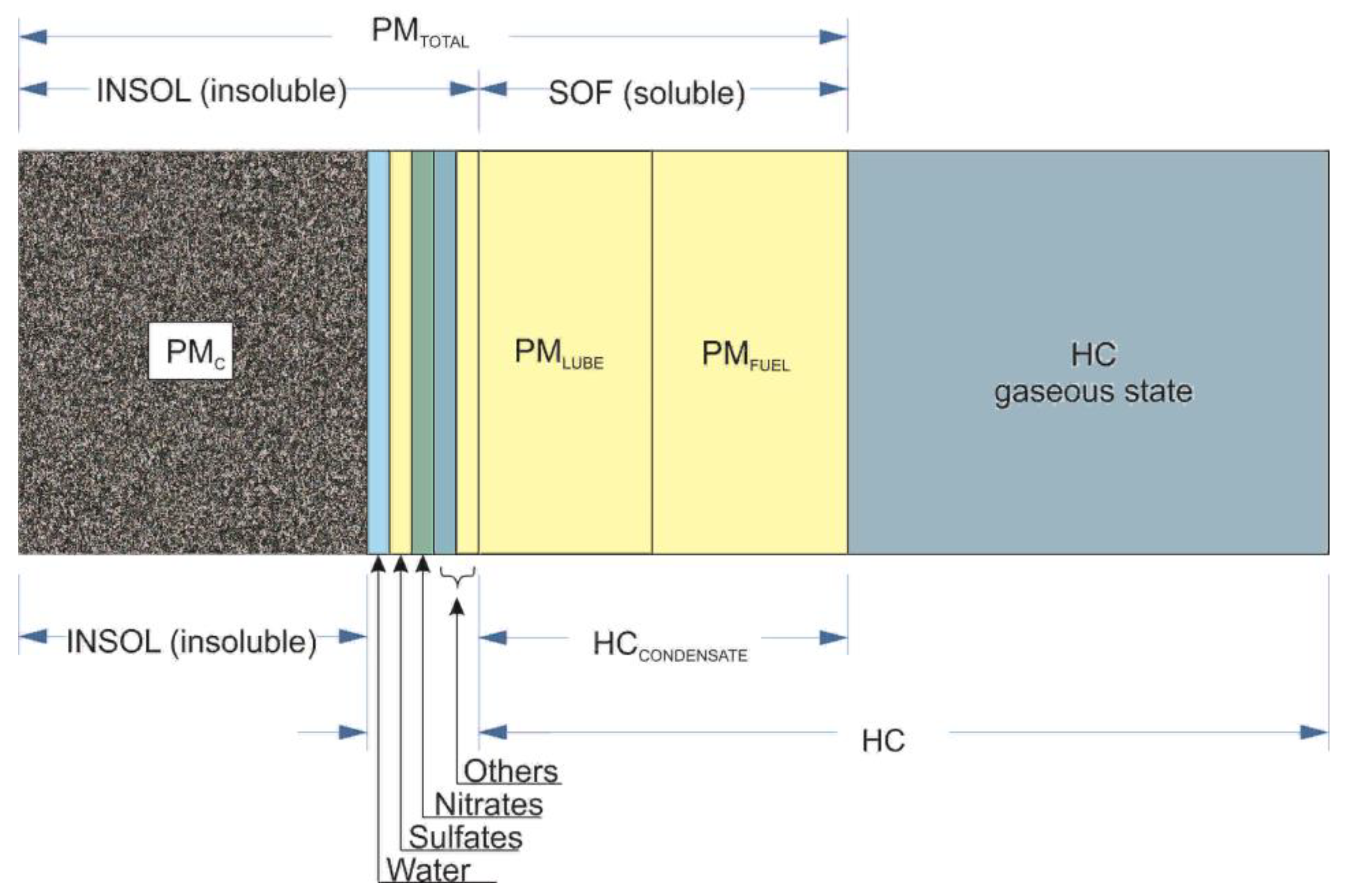

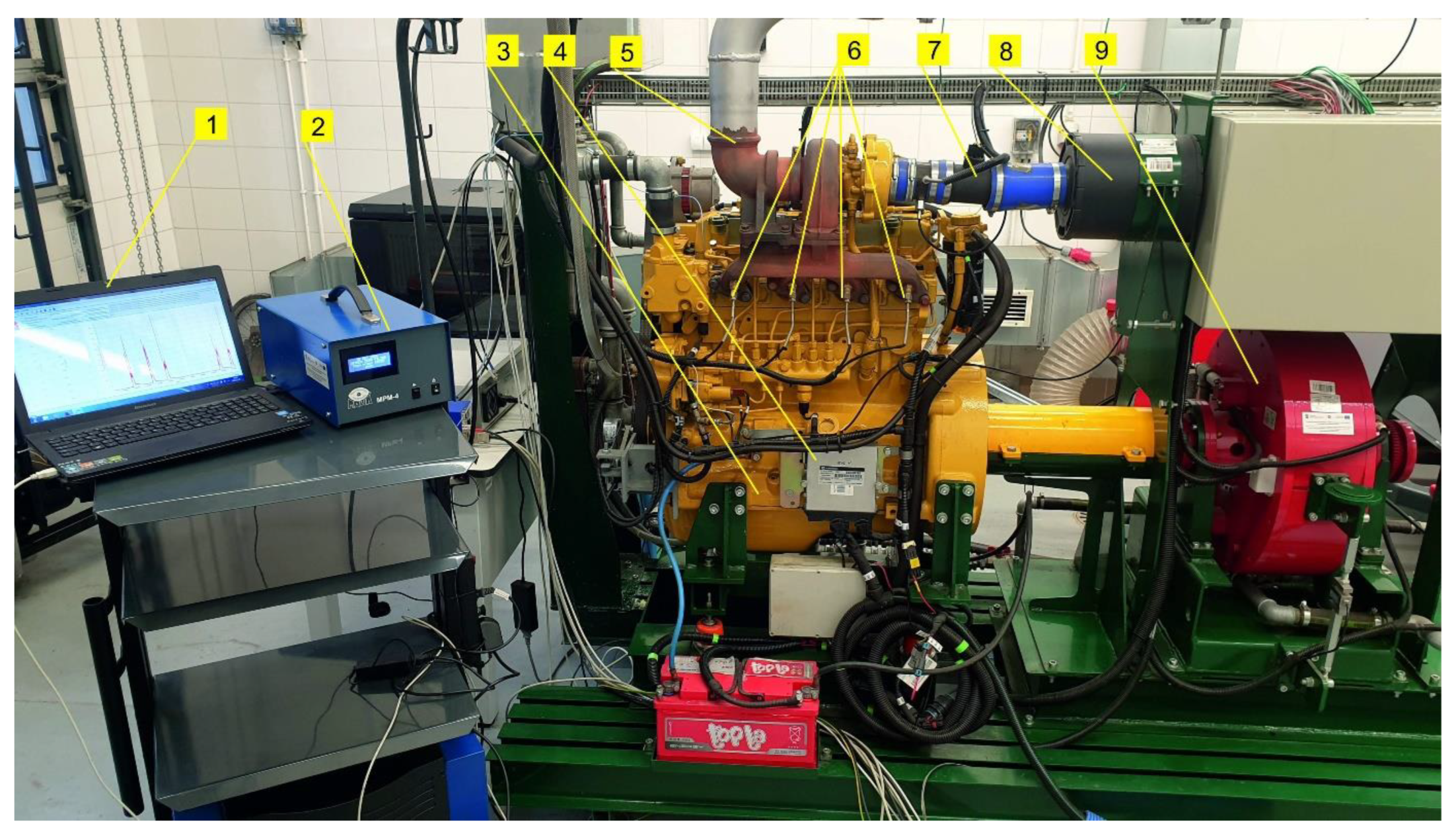
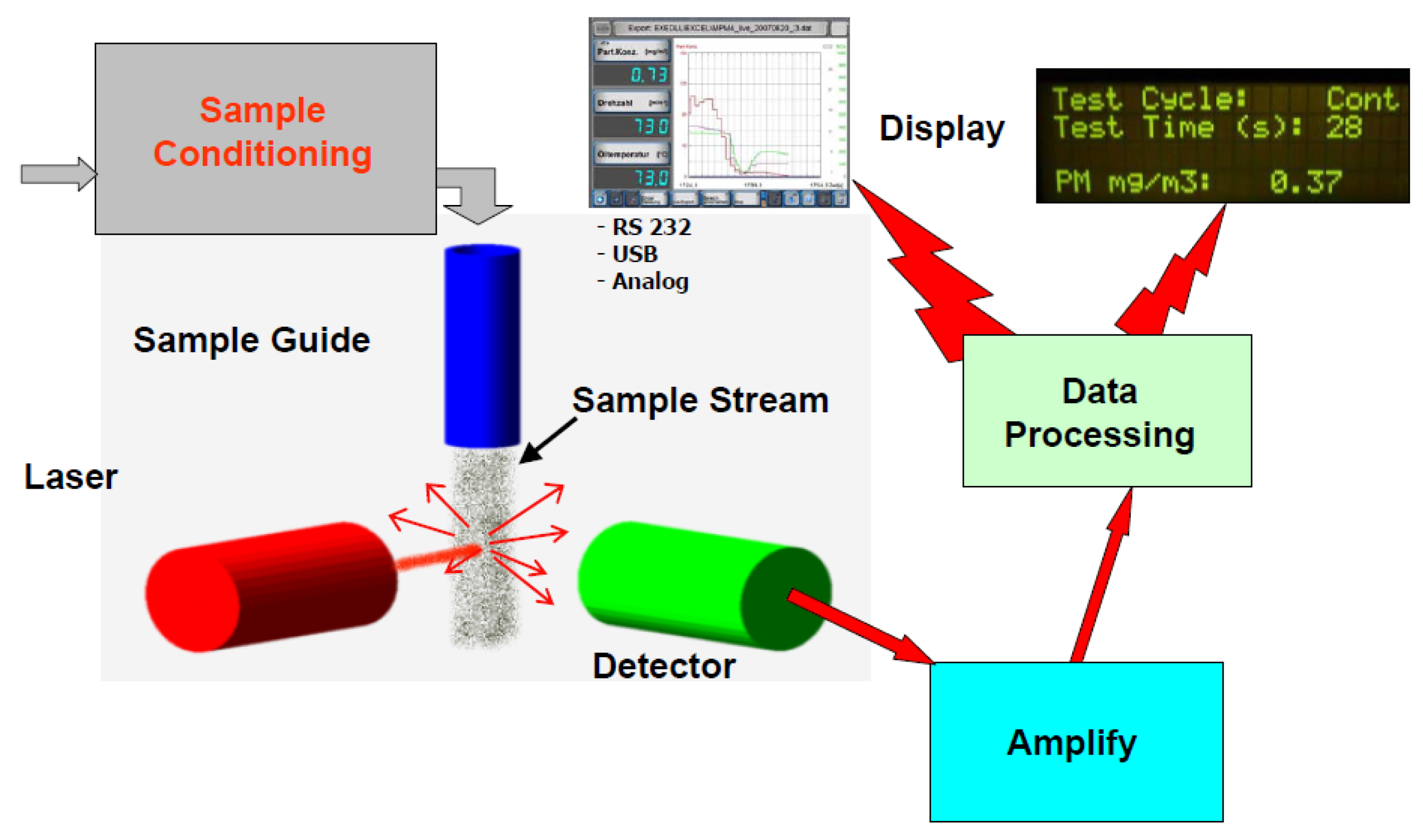
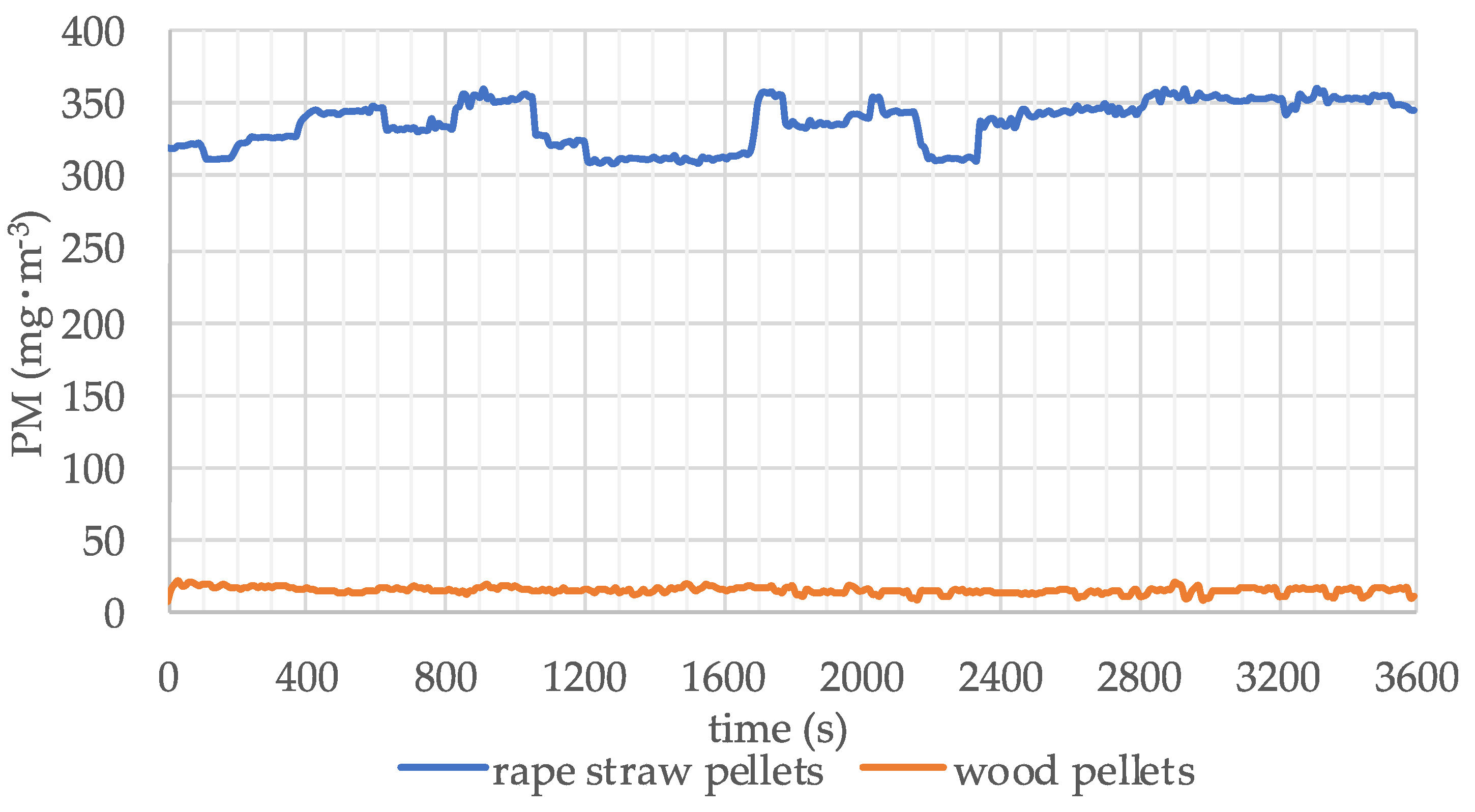
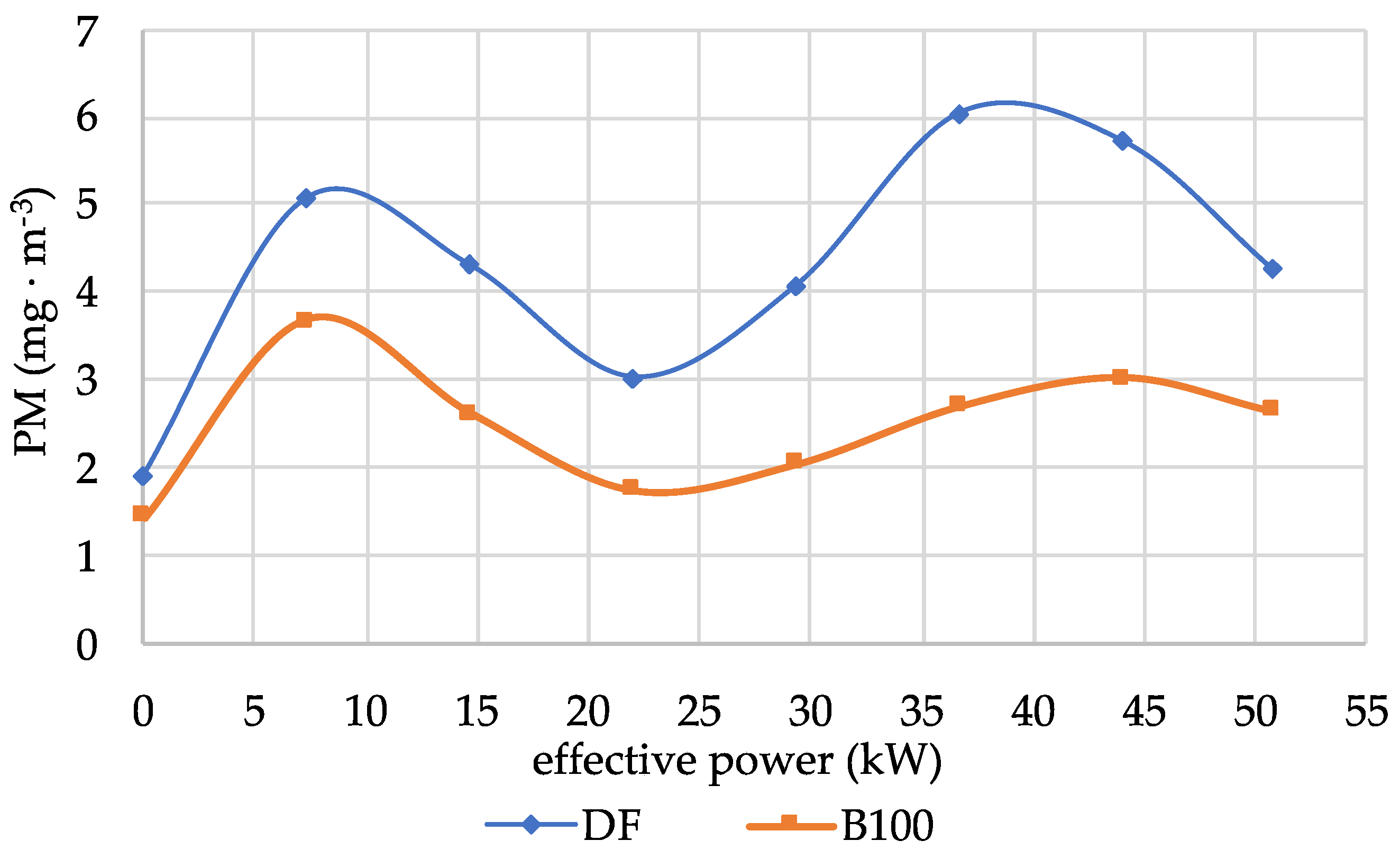

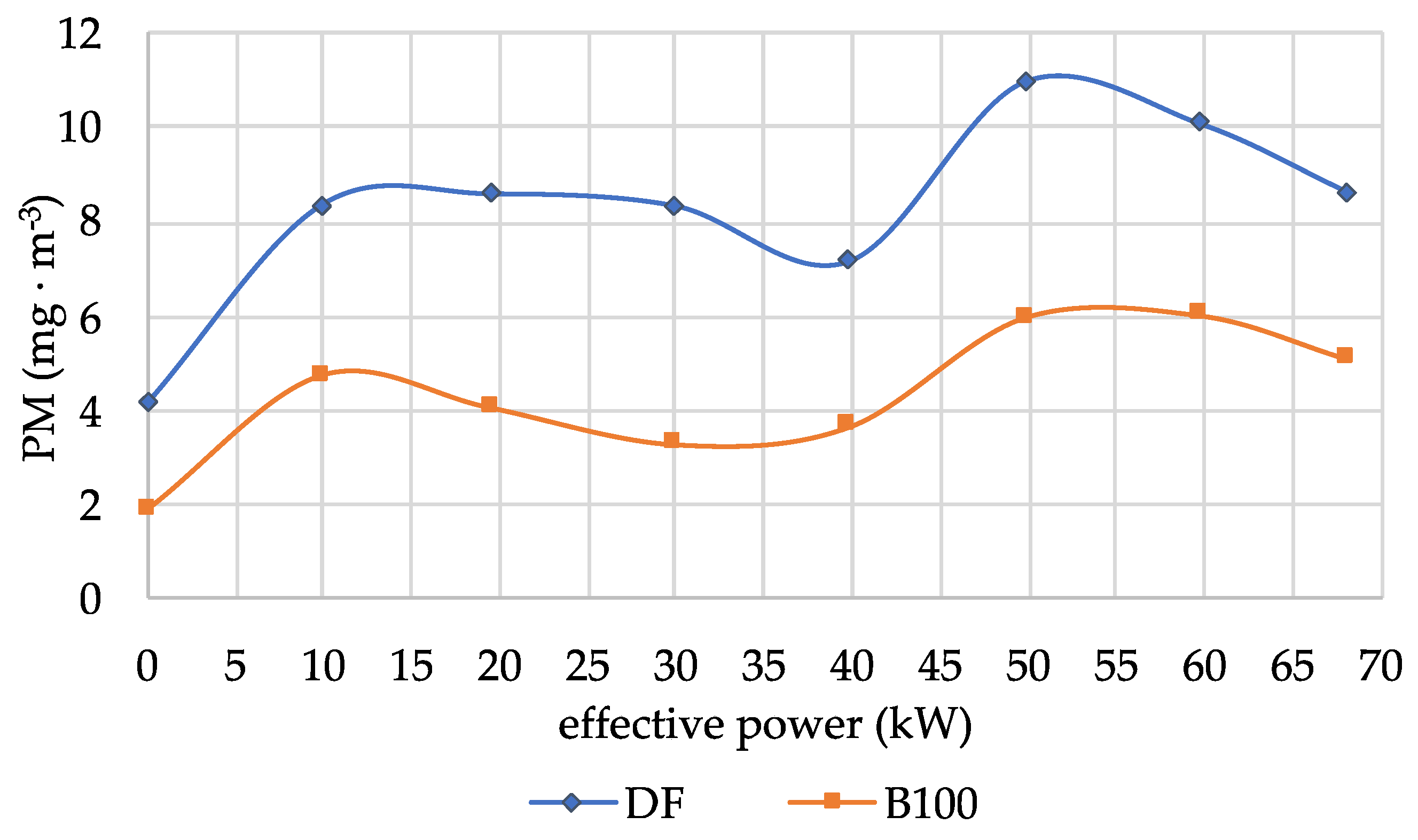
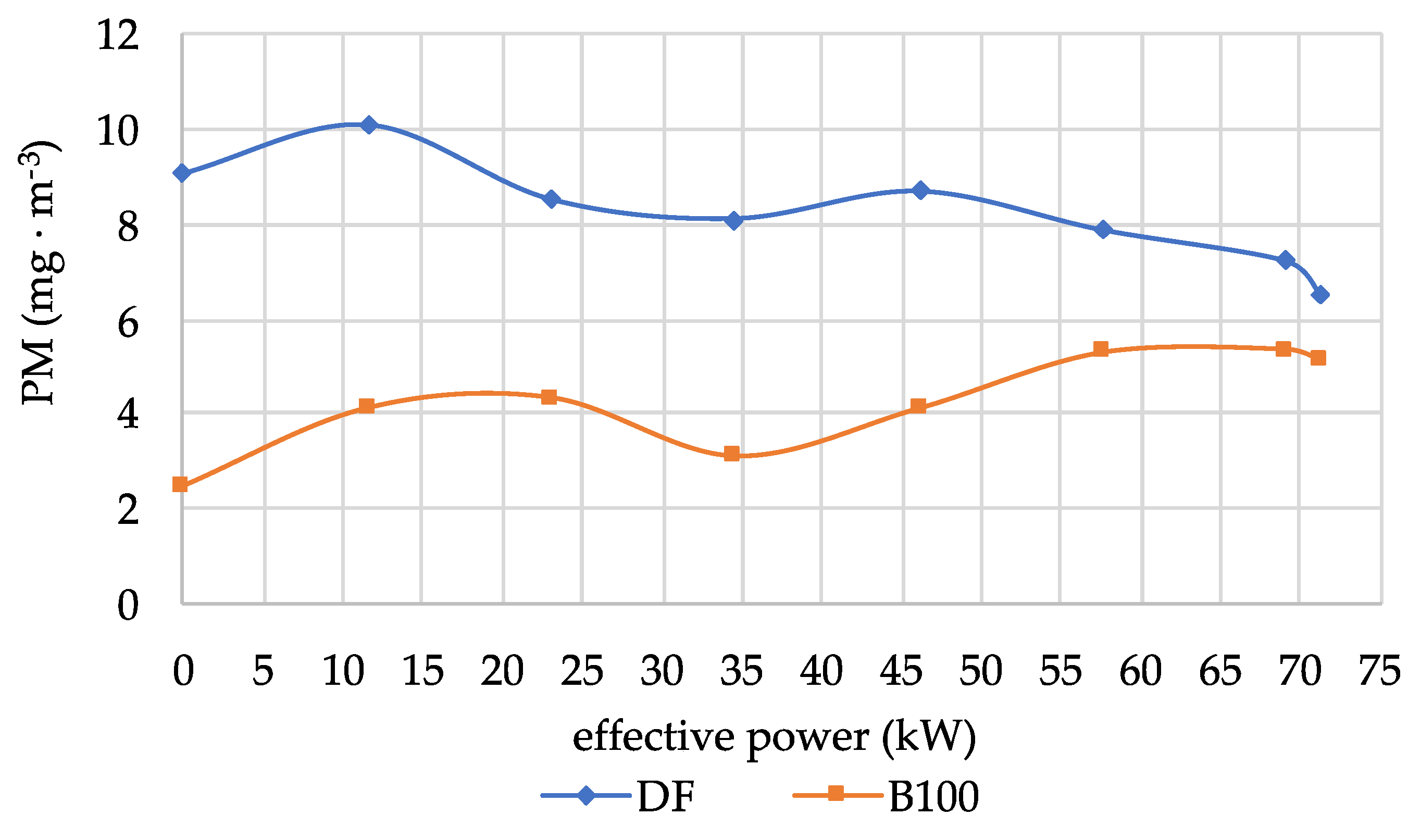

| Parameter | Wood Pellets | Rape Straw Pellets |
|---|---|---|
| Carbon (%) | 49.5 | 40.1 |
| Hydrogen (%) | 6.06 | 5.8 |
| Nitrogen (%) | 0.17 | 0.8 |
| Sulfur (%) | 0.02 | 0.31 |
| Oxygen (%) * | 38.25 | 33.19 |
| Moisture (%) | 5.7 | 9.4 |
| Volatile matter (%) | 84.45 | 64.7 |
| Ash (%) | 0.3 | 10.4 |
| LHV (MJ∙kg−1) | 17.89 | 14.76 |
| HHV (MJ∙kg−1) | 19.95 | 15.97 |
| Parameter | DF | B100 |
|---|---|---|
| Cetane number | 51.4 | 52.1 |
| Density @ 15 °C (kg·m−3) | 835 | 883 |
| Viscosity @ 40 °C (mm2·s−1) | 2.6 | 4.47 |
| Flash point (°C) | 69 | 120 |
| FAME content (% w/w) | 6.8 | 98.8 |
| Carbon (%) | 85.7 | 76.9 |
| Hydrogen (%) | 10.6 | 11.9 |
| Oxygen (%) | 2.4 | 10.3 |
| LHV (MJ·kg−1) | 43.51 | 37.92 |
| HHV (MJ·kg−1) | 45.84 | 40.36 |
| Parameter | Characteristics |
|---|---|
| Engine type | Self-ignition engine |
| Engine displacement | 4.5 dm3 |
| Injection system | direct injection |
| Fuel System | Mechanical governor |
| Aspiration | Turbocharged |
| Cylinder arrangement and number | In-Line, 4-Cycle |
| Compression ratio | 19:1 |
| Nominal power | 74 kW |
| Nominal speed | 2400 rpm |
| Peak torque | 353 Nm |
| Peak torque speed | 1600 rpm |
| Specification | Wood Pellets | Rape Straw Pellets |
|---|---|---|
| PM (mg·m−3) | 15.45 | 336.9 |
| EF (mg·kg−1) | 797 | 23,282 |
| EF (mg·MJ−1) | 44.5 | 1589 |
| Fumes’ Component | Factor | Degrees of Freedom df | Totals of Squares SS | Medium Square MS | Test Function Value F | Calculated Significance Level p |
|---|---|---|---|---|---|---|
| PM | Fuel wood pellets and rapeseed straw pellets) | 1 | 18,659,683 | 18,659,683 | 161,346.3 | 0 |
| PM | Fuel DF and B100 | 1 | 460.6794 | 460.6794 | 50.28063 | 0 |
Disclaimer/Publisher’s Note: The statements, opinions and data contained in all publications are solely those of the individual author(s) and contributor(s) and not of MDPI and/or the editor(s). MDPI and/or the editor(s) disclaim responsibility for any injury to people or property resulting from any ideas, methods, instructions or products referred to in the content. |
© 2022 by the authors. Licensee MDPI, Basel, Switzerland. This article is an open access article distributed under the terms and conditions of the Creative Commons Attribution (CC BY) license (https://creativecommons.org/licenses/by/4.0/).
Share and Cite
Szyszlak-Bargłowicz, J.; Wasilewski, J.; Zając, G.; Kuranc, A.; Koniuszy, A.; Hawrot-Paw, M. Evaluation of Particulate Matter (PM) Emissions from Combustion of Selected Types of Rapeseed Biofuels. Energies 2023, 16, 239. https://doi.org/10.3390/en16010239
Szyszlak-Bargłowicz J, Wasilewski J, Zając G, Kuranc A, Koniuszy A, Hawrot-Paw M. Evaluation of Particulate Matter (PM) Emissions from Combustion of Selected Types of Rapeseed Biofuels. Energies. 2023; 16(1):239. https://doi.org/10.3390/en16010239
Chicago/Turabian StyleSzyszlak-Bargłowicz, Joanna, Jacek Wasilewski, Grzegorz Zając, Andrzej Kuranc, Adam Koniuszy, and Małgorzata Hawrot-Paw. 2023. "Evaluation of Particulate Matter (PM) Emissions from Combustion of Selected Types of Rapeseed Biofuels" Energies 16, no. 1: 239. https://doi.org/10.3390/en16010239
APA StyleSzyszlak-Bargłowicz, J., Wasilewski, J., Zając, G., Kuranc, A., Koniuszy, A., & Hawrot-Paw, M. (2023). Evaluation of Particulate Matter (PM) Emissions from Combustion of Selected Types of Rapeseed Biofuels. Energies, 16(1), 239. https://doi.org/10.3390/en16010239










